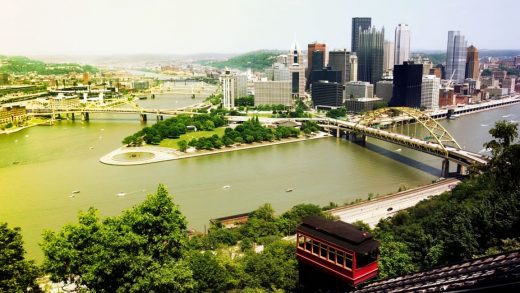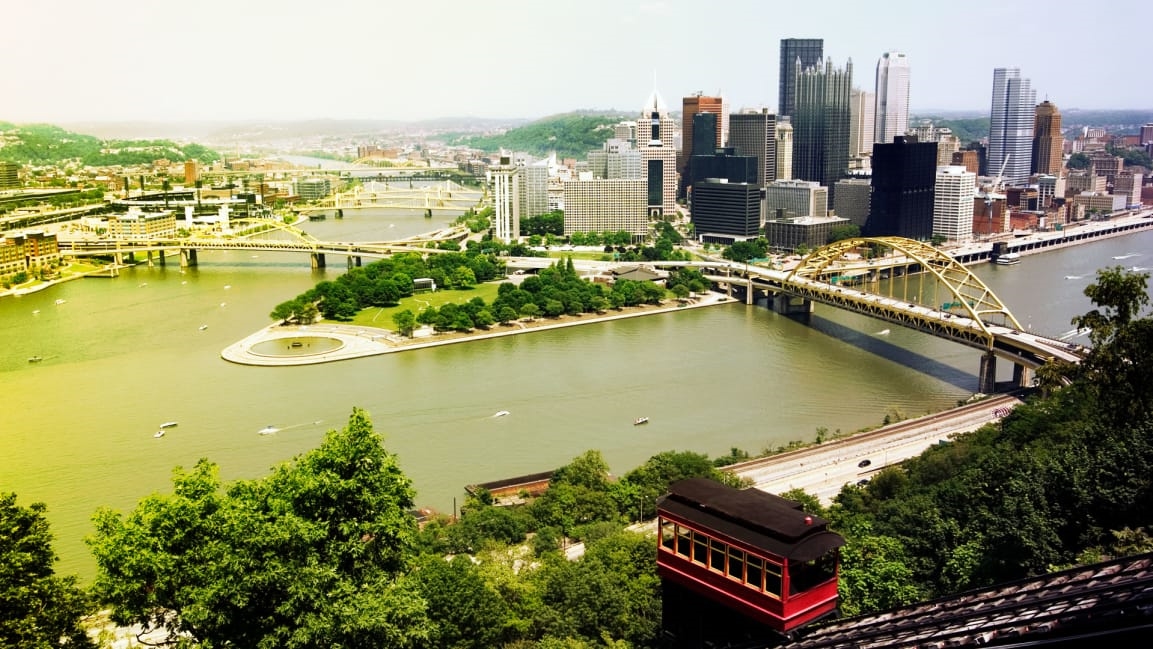How America’s dying rust belt town can transform into “smart cities” of the future
The death of the American manufacturing sector made ghost towns out of cities across America.
In these challenging times, some cities were successful at reinventing themselves and went on to forge new economies and transform their once-sprawling, empty lands into something new, something remarkable. Year after year, Pittsburgh appears on best cities for jobs lists, thanks to its burgeoning tech industry after a desperate decline following the fall of American steel. Then there are other cities, like Detroit, that have a tougher time recovering after their major industry dried up.
What is it that allows some cities to escape the “boom and bust” town narrative to become livable, workable, and sustainable? And can these models be replicated in other small, struggling towns?
An ecosystem for innovation
Christina Cassotis, the Pittsburgh International Airport’s first female CEO, hopes that the city’s economic innovation can be felt from the moment visitors land. The airport has partnered with Carnegie Mellon University (CMU) to run an “innovations lab” that will test how automation and robotics can help the airport run “more efficiently, raise revenue, operate better, and improve the passenger experience,” Cassotis says.
“If we do it right, we will impact the industry from here,” she adds. “From here, there will be learning, there will be products, there will be processes that comes out of this [new] terminal and the way we work that will make the (airport) industry better.”
In Pittsburgh, CMU is the epicenter of innovation where the self-driving car was born in the 1980s. Since then, CMU has acted as a hub for collaborations and entrepreneurial activity, filling the city’s Oakland and Lawrenceville neighborhoods with coworking spaces, incubators, and accelerators.
CMU’s spin-offs include RE2 Robotics, which develops robotic arms to help dismantle explosives and underwater robots for missions deemed dangerous for humans, and Bossa Nova, which makes scanning-inventory robots deployed in 50 stores across the U.S., including Walmart.
When Sarjoun Skaff, cofounder and CTO of Bossa Nova, moved to Pittsburgh from Beirut, Lebanon to study robotics at CMU in 1999, he describes the city as “not a joyful place.”At that time, Pittsburgh was still crumbling, had suffered a loss of population, and no one knew what a future without steel would look like. But it was CMU, which Skaff describes as “absolutely awesome,” that shaped his success.
“My life revolved around Carnegie Mellon,” he tells Fast Company. “Everyone helped in creating Bossa Nova.” The company, which has offices in Pittsburgh and Silicon Valley, recently secured $29 million in investment capital, bringing its total funding to $70 million.
By the time Felix Lloyd moved to Pittsburgh in 2007, the city was in much better shape, and is described by Lloyd as “a simple cosmopolitan.”
“[Pittsburgh] has good food, but is unassuming in the ways that D.C. is not,” says Lloyd, who is from Virginia and was named Teacher of the Year in Washington, D.C. in 2001.
“It’s smart, but not in an elitist way.”
Lloyd points to Pittsburgh’s rich startup culture as contributing to his success in entrepreneurship. Shortly after moving to the city that he only knew as “a steel city full of smoke,” Lloyd founded his first company, Skill-Life, which developed MoneyIsland (formerly called CentsCity), a platform that allows young people to learn financial skills and earn rewards. He sold the company and founded a second, Zoobean, with his cofounder Jordan Bookey. When the two were invited on the ABC reality pitch show Shark Tank in 2014, Lloyd turned to Innovations Works, the seed-stage investor in the Pittsburgh region, to rehearse for their appearance (the company went on to receive investment from businessman Mark Cuban). Since its inception in 1999, Innovations Works has invested $78 million in 367 companies, including the seed funding it provided RE2 Robotics.
Similar to Pittsburgh, Madison, Wisconsin is another city relying on its university community for its bread and butter. The city’s nonprofit Wisconsin Alumni Research Foundation (WARF) Accelerator Program is the nation’s first designated patent and licensing organization. Since 1925, the organization has provided everything from funding to advice to turn research and innovation that comes out of the University of Wisconsin-Madison (UW-Madison) into commercially promising technologies.
Jon Eckhardt, cofounder of accelerator program Gener8tor–considered one of the best startup accelerators in the country–moved to Madison 15 years ago and says he’s most excited about “the current change in the [city’s] mood.”
“If you look at educated people per capita, this place is off the charts,” he says. “People are more action-oriented and there’s been much more involvement in the entrepreneurship community.”
Eckhardt, who is also a faculty member at the UW-Madison, recently received funding for a three-year study to examine entrepreneurship among students.
A new identity: keeping the past in the past
At its peak, Pittsburgh produced 60% of the nation’s steel during its “Golden Age,” between 1870 and 1910. The manufacturing decline came in the 1970s and cities like Pittsburgh and Detroit were hit hard with massive population loss, high unemployment rates, and crumbling infrastructures.
Perhaps Pittsburgh’s ability to keep the past in the past led to its success ahead of Rust Belt cities with similar legacies, like Detroit and Cleveland. Instead of injecting more money into steel, long after these jobs traveled overseas, Pittsburgh forged ahead in industries like healthcare, medicine, and education, and sectors like robotics.
Pittsburgh’s transformation from “Steel City” to brain city helps it get the attention of big-time players from coastal cities (80% of VC dollars in the first quarter of 2018 went into companies in three states: California, Massachusetts, and New York).
Dietrich Stephan completed his undergraduate and graduate studies in Pittsburgh–first at CMU, then at the University of Pittsburgh–but the city didn’t come back on his radar for another 20 years. In 2012, while writing an article for the Harvard Business Review about regions that had the ecosystem and innovation base needed to develop solutions to solve the world’s biggest health problems, Stephan saw the opportunity in Pittsburgh and moved back to the city from Silicon Valley.
He founded LifeX to provide the infrastructure and funding to early-stage health science research companies seeking to commercialize their work.
“The visual image that I always have is of the super collider where you accelerate a particle around a ring and then collide it with another particle,” says Stephan of Pittsburgh’s ecosystem. “And what emerges is something that the world has never seen before.”
When comparing Pittsburgh to Silicon Valley, Stephen, who is a serial entrepreneur with 14 companies under his belt, says “the innovation is just as good,” but “the entrepreneurs are hungrier.”
“This is historically a blue collar town,” he adds, “and people are willing to work hard to make things happen. There is very little sense of entitlement.”
Forging ahead and creating a new identity isn’t always a one-size-fit-all model. The model can be hard to replicate for other small, struggling towns. About 50 miles from the capital city of Madison, Beloit, Wisconsin is going through a sort of economic revival, thanks to the millions of dollars poured into the city’s development by Diane Hendricks, who is Forbes’s 2018 richest self-made woman in America. Hendricks is the cofounder of ABC Supply Company, which started as a modest roofing company and is now the largest roofing distributor in the U.S., with more than 700 locations and $9 billion in sales. Hendricks is a business engine felt in every part of the city, from the real estate she owns to her investments in companies like Beloit-based NorthStar Medical Radioisotopes, which provides mo-99, a scarce substance used to detect cancer and other potentially life-threatening illnesses (Wisconsin is home to NorthStar and Shine Medical Technologies Inc.–the only two companies currently approved to provide mo-99 in the U.S.). Hendricks woos startups to come to Beloit and is said to have convinced Wisconsin’s governor Scott Walker to personally call and persuade cofounders to help her efforts, according to this 2017 New York Times profile.
Models like this where one person or company has so much influence in a city’s economic survival receive a lot of backlash, but we see them in small towns throughout America.
In Verona, Wisconsin, health records company Epic Systems employs about 10,000 people, who mostly live in nearby Madison. The result has a major impact in the local economy, and you can see it in the increasing numbers of high-rises sprouting up in recent years to accommodate those employees (Epic Founder and CEO Judy Faulkner is the third-richest self-made woman in America, according to Forbes).
What happens to what’s left behind?
It makes sense that cities are doing what they can to bring in new tech havens and new industries to attract new, young talent to the area. Kansas City is deploying public Wi-Fi throughout its downtown area to close the digital divide and collecting data in real-time, like how long it takes a car to drive around before it finds a parking space, to inform decision-makers about infrastructure design, says Bob Bennett, the city’s chief innovation officer.
“I would really like us to get to a point that people think about our technology in the same way as they think about our BBQ,” says Bennett.
However, as industries come and go, cities can’t truly transform into “smart” cities of the future without thinking about how to transform what’s left behind, like vacant properties and workers from former industries left without an identity or purpose.
In Baltimore, companies like Catalyte are providing skills and opportunity to unlikely engineers, no matter their background. In an interview with Fast Company, Michael Rosenbaum, a former advisor in the Clinton White House and founder of Catalyte, said: “If the model is successful, the wage gap narrows and desolated, post-manufacturing cities forgotten about after their industries collapsed, can start rebuilding themselves.”
In Pittsburgh, nonprofits like Grounded Strategies work with local communities to transform vacant lots–sometimes entire blocks–into greenspace projects. Since its founding in 2007 out of research from CMU’s School of Public Policy & Management at Heinz College, Grounded Strategies has been involved in nearly 200 projects in 45 neighborhoods (Pittsburgh has 90 neighborhoods).
Working closely with residents is key to the projects’ sustainability, says Evaine Sing, executive director of Grounded Strategies.
“It encourages the independence of decision-making and implementations of strategies versus waiting for new people to come in and do it for you,” Sing tells Fast Company. “People who live there know it best but in the cities that we’re in, no one else is coming, so if you’re waiting, you’re waiting for a very long time.”
Another nonprofit, 412 Food Rescue, called the “Uber of food recovery,” was created by CMU graduate Leah Lizarondo to recover food that would otherwise end up in the trash. The organization currently has 7,000 volunteers–called “food rescue heroes”–on its app and has moved 4.5 million pounds of food into the hands of people who need it most.
Unlike food banks, 412 Food Rescue does not keep food as inventory: “Before the driver picks up [the food], it has a route and it has a nonprofit that it’s going to,” says Lizarondo. “[They] pick up then deliver to nonprofits that [412 Food Rescue] works with to serve people in poverty. They see a value in it. They feel good about it. They see the good in it. They see the impact right away. The food never goes to a warehouse.”
Getting cities to adapt and be “smarter” isn’t easy, but it’s necessary. Cities are complex, living ecosystems that can only thrive if they look toward the future, rather than getting dragged down by the past. At the same time, cities can’t truly transform if they’re only focused on inviting new talent and new economies without preparing workers from the old economies on how to foster and thrive. What will happen when 50% of U.S. jobs are lost to automation? How will cities prepare then?
(75)



